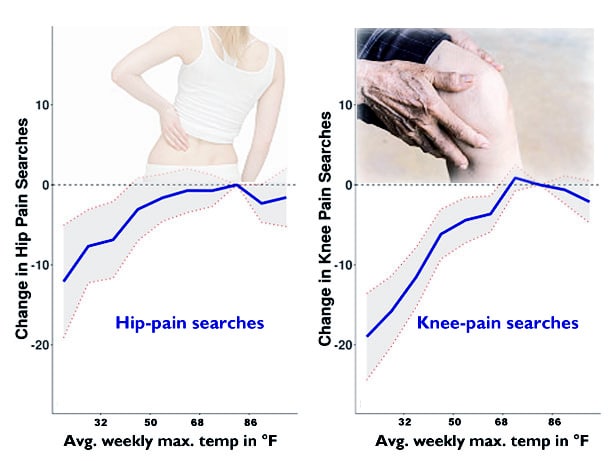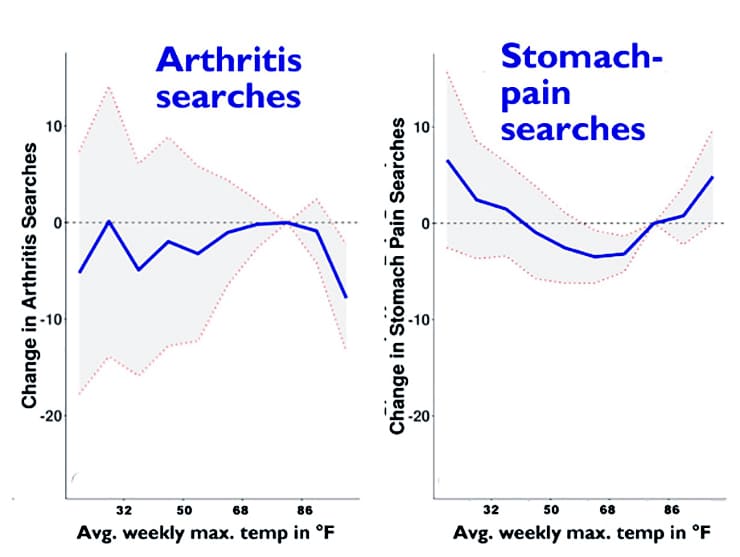While some people with achy joints or arthritis say that the weather influences their pain, a new study using Google search data suggests that activity level is more likely to cause pain than the weather itself.
Weather is associated, however, with an increase in the number of Google searches about joint pain in 45 cities in the United States. It just might not be the association you’d expect.
As temperatures rose within the study’s focus span of 23 degrees to 86 degrees Fahrenheit, searches about knee and hip pain rose steadily, too, researchers found. Knee-pain searches peaked at 73 degrees and were less frequent at higher temperatures. Hip-pain searches peaked at 83 degrees and then tailed off. Rain actually dampened search volumes for both.

“We were surprised by how consistent the results were throughout the range of temperatures in cities across the country,” says Scott Telfer, a University of Washington Medicine researcher in orthopedics and sports medicine.
The researchers used Google Trends, a resource that reflects global use of the company’s search engine. They created search strings of words and phrases for hip pain, knee pain, and arthritis, as well as a control search related to stomach pain.
From the 50 most populous US cities, they sought daily summaries of local weather data from Jan. 1, 2011, to Dec. 31, 2015. The data included temperature, precipitation, relative humidity, and barometric pressure—variables previously suggested as associated with increases in musculoskeletal pain. Five cities were dropped from the final results due to incomplete data.
Google Trends expresses data in weekly, not daily, increments, which slightly limited the findings’ precision vis-à-vis time. Temperatures and searches below 23 degrees were aggregated into one group, as were temperatures and searches above 86 degrees. Those two groups of combined temperatures correspond with somewhat less scientific confidence, Telfer acknowledges, but the trend of fewer searches, relative to both 23 and 86 degrees, was evident in each group.

Among the weather variables, only temperature and precipitation were found to have statistically significant associations, and only with searches for knee and hip pain. Searches about arthritis, which Telfer says was the study’s impetus, had no discernible correlation with weather factors.
“You hear people with arthritis say they can tell when the weather is changing,” he says. “But with past studies there’s only been vague associations, nothing very concrete, and our findings align with those.”
Test could find arthritis before your joints hurt
The stomach-pain searches functioned well as a control: Those volumes were greater at low and high temperature extremes and ebbed in mild temperatures, a very different pattern from the knee- and hip-pain searches.
Because knee- and hip-pain searches increased as temperatures rose until it grew uncomfortably hot, and rainy days tended to slightly reduce search volumes for hip and knee pain, the researchers inferred that “changes in physical activity levels” were primarily responsible for those searches.
“We haven’t found any direct mechanism that links ambient temperature with pain. What we think is much more likely explanation is the fact that people are more active on nice days, so more prone to have overuse and acute injuries from that and to search online for relevant information. That’s our hypothesis for what we’ll explore next,” says Telfer, an acting assistant professor in orthopedics and sports medicine at the University of Washington School of Medicine.
The interest in using internet data, he adds, stems from the fact that web searches are increasingly people’s first response to experiencing adverse health symptoms.
Nanoparticles injected into achy joints last for weeks
The study appears in PLOS ONE. Telfer collaborated with Nick Obradovich, a postdoctoral fellow in science, technology, and public policy at Harvard University.
Source: University of Washington



